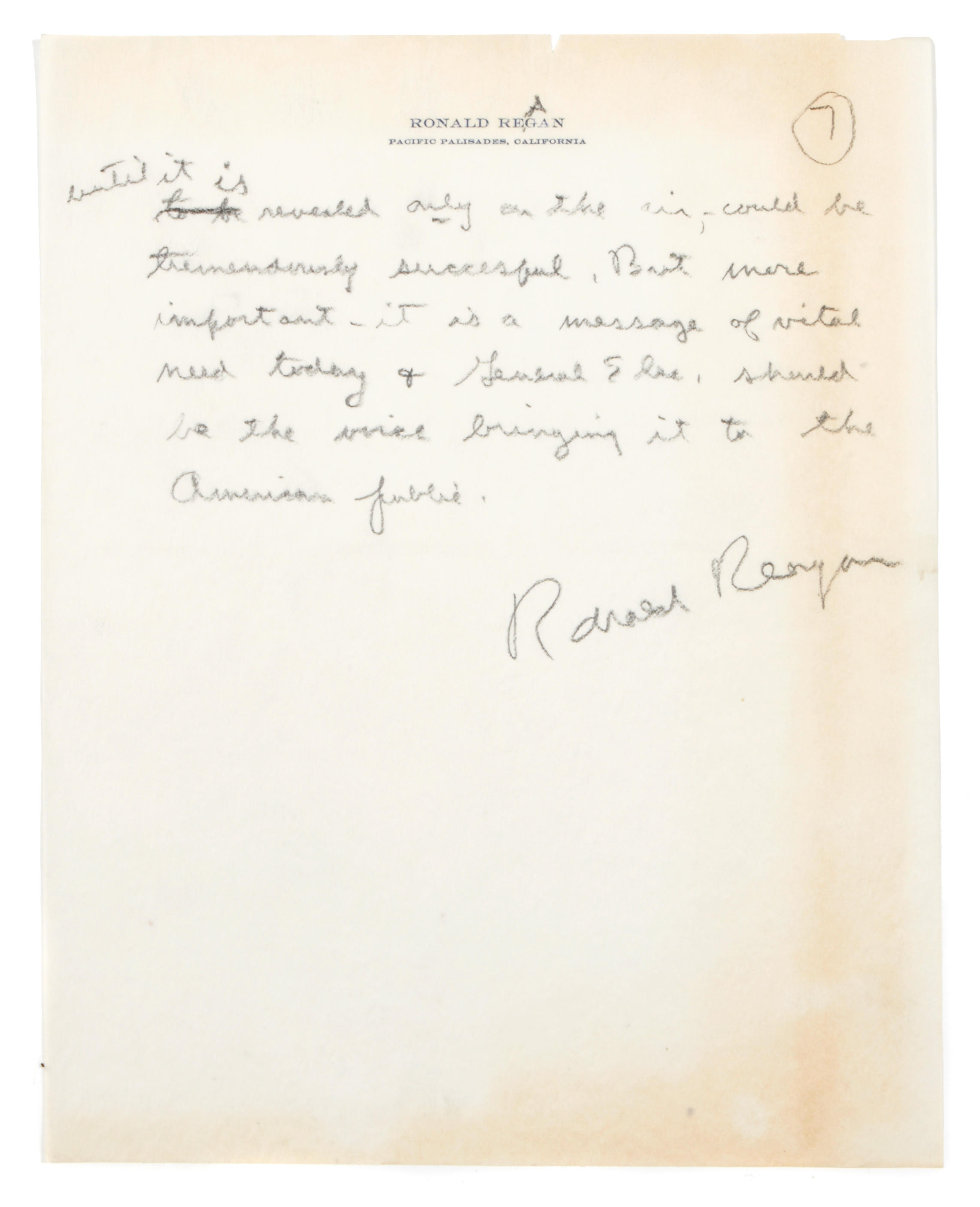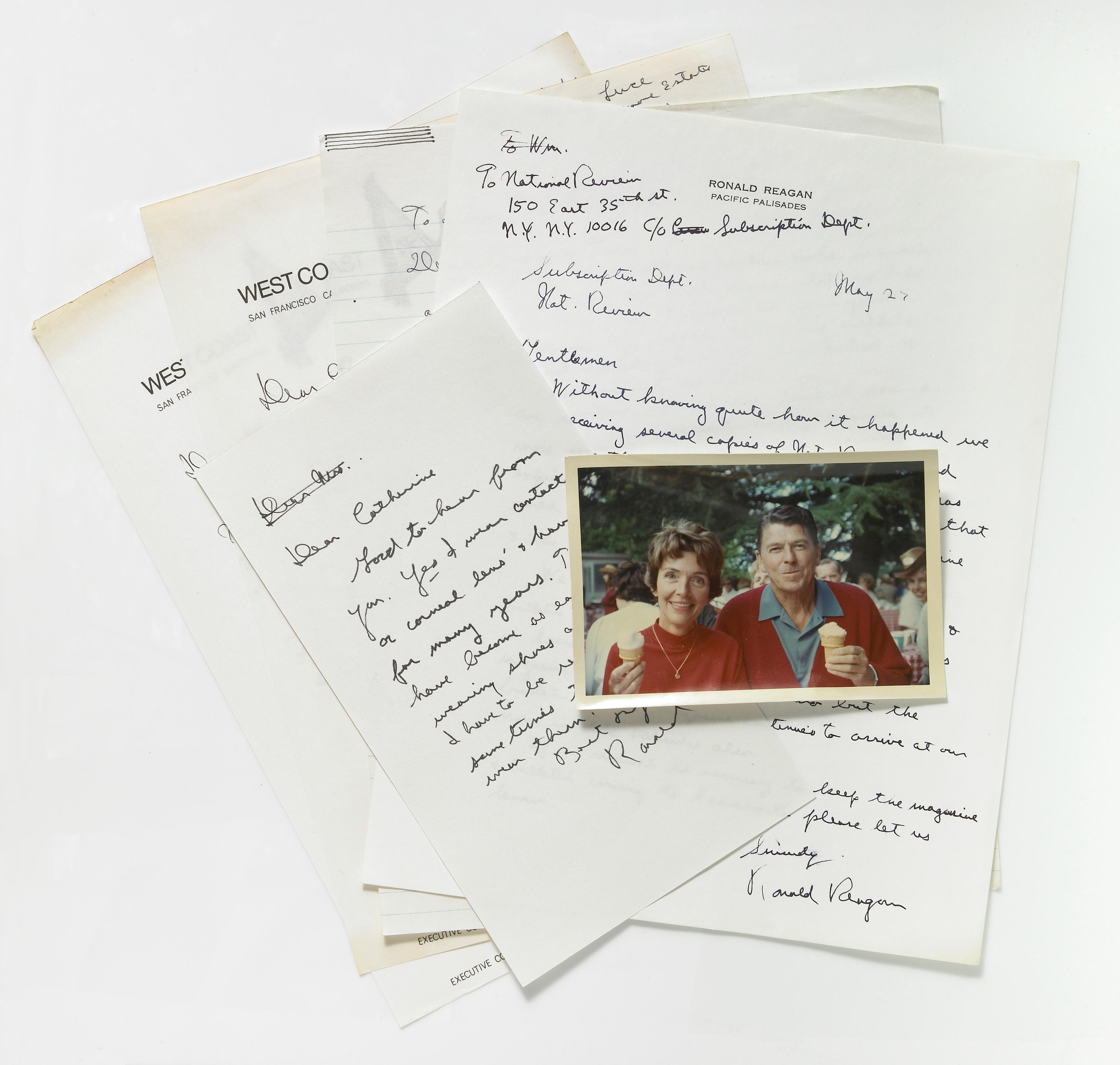Reagan, Ronald Highly important series of 37 letters signed ("Ron") to Senator George Murphy ("Dear Murph"), two autograph, the remainder typed, four signed with autopen, a revealing political correspondence to a long-standing friend and trusted ally, the vast majority written during his two presidential terms, touching on subjects ranging from Carter's mishandling of the Iranian hostage crisis to glasnost and the changes in the Soviet Union, as well as the Iran-Contra affair, Apartheid South Africa, Supreme Court nominations, and the partisan battles of American politics, 39 pages, Sacramento, Los Angeles (various addresses), and the White House, with 30 envelopes, 4 June 1968 to 4 July 1990 [with:] an inscribed photograph of Ronald Reagan ("Why am I reminded of the S.AG. Board meetings? All the Best & Warmest Friendship. Ron"); an autograph letter signed by Nancy Reagan, 2 pages, n.d.; an inscribed photograph of Nancy Reagan, 1968-90; two printed invitations; three telegrams; two Christmas cards (unsigned) "...I am looking forward to putting our mandate into action. I'm aware it will be all uphill but we'll keep climbing..." (14 November 1984) REAGAN'S LETTERS TO GEORGE MURPHY, THE FELLOW ACTOR AND REPUBLICAN POLITICIAN HE REFERRED TO AS "MY JOHN THE BAPTIST". George Murphy (1902-92) was the first prominent Hollywood actor to launch a major national political career. The first of these letters dates from 1968 but the relationship between Murphy and Reagan went back to their careers in Hollywood in the early 1940s. Murphy had played Reagan's father in the wartime propaganda musical This is the Army, and the two men had served as successive presidents of the Screen Actors' Guild in the '40s and '50s. Their on-screen personae were very different - Reagan tended to play cowboys and other men of action, Murphy was primarily a song-and-dance man - but they had similar political instincts. Murphy was elected to the US Senate in 1964, two years before Reagan became Governor of California; they supported each other's campaigns in the 1960s and remained close friends and political allies through Reagan's presidency and beyond. The most significant letters in the current series are undoubtedly Reagan's two letters written after meetings with Gorbachev. In the first, Reagan sums up for his friend the 1985 Geneva Summit, where he had first met the new Soviet leader: "...it was worthwhile but it would be foolish to believe the leopard will change its spots. He is a firm believer in their system... and he believes the propaganda they peddle about us. At the same time, he is practical and knows his economy is a basket case. I think our job is to show him he and they will be better off if we make some practical agreement, without attempting to convert him to our way of thinking..." (19 December 1985) Three years later, in the aftermath of the Moscow Summit, Reagan had a clear understanding of the world-changing significance of the reforms within the USSR itself. This came as much from his evident astonishment at the warmth of his public reception in Moscow as from his meetings with the Soviet leadership: "...the people have, of course, heard of glasnost and evidently liked what they heard. Murph, for the first time I believe there could perhaps one day be a stirring of the people that would make the bureaucrats pay attention. The Estonians have demanded home rule and no one is shooting at them. In Leningrad a mob of 2,000 marched on the KGB headquarters and the KGB just stayed inside. If glasnost was just showboating, they may have to keep at least some of the promises or face a public they've never seen before..." (8 July 1988) Whilst these letters are exceptional examples of Reagan as a clear-eyed statesman, taken as a whole the correspondence provides a narrative of a presidential career from its origins to its conclusion. In the earliest letters Reagan is Governor of California, but by June 1976 he is "busy job-hunting" having failed to
Reagan, Ronald Highly important series of 37 letters signed ("Ron") to Senator George Murphy ("Dear Murph"), two autograph, the remainder typed, four signed with autopen, a revealing political correspondence to a long-standing friend and trusted ally, the vast majority written during his two presidential terms, touching on subjects ranging from Carter's mishandling of the Iranian hostage crisis to glasnost and the changes in the Soviet Union, as well as the Iran-Contra affair, Apartheid South Africa, Supreme Court nominations, and the partisan battles of American politics, 39 pages, Sacramento, Los Angeles (various addresses), and the White House, with 30 envelopes, 4 June 1968 to 4 July 1990 [with:] an inscribed photograph of Ronald Reagan ("Why am I reminded of the S.AG. Board meetings? All the Best & Warmest Friendship. Ron"); an autograph letter signed by Nancy Reagan, 2 pages, n.d.; an inscribed photograph of Nancy Reagan, 1968-90; two printed invitations; three telegrams; two Christmas cards (unsigned) "...I am looking forward to putting our mandate into action. I'm aware it will be all uphill but we'll keep climbing..." (14 November 1984) REAGAN'S LETTERS TO GEORGE MURPHY, THE FELLOW ACTOR AND REPUBLICAN POLITICIAN HE REFERRED TO AS "MY JOHN THE BAPTIST". George Murphy (1902-92) was the first prominent Hollywood actor to launch a major national political career. The first of these letters dates from 1968 but the relationship between Murphy and Reagan went back to their careers in Hollywood in the early 1940s. Murphy had played Reagan's father in the wartime propaganda musical This is the Army, and the two men had served as successive presidents of the Screen Actors' Guild in the '40s and '50s. Their on-screen personae were very different - Reagan tended to play cowboys and other men of action, Murphy was primarily a song-and-dance man - but they had similar political instincts. Murphy was elected to the US Senate in 1964, two years before Reagan became Governor of California; they supported each other's campaigns in the 1960s and remained close friends and political allies through Reagan's presidency and beyond. The most significant letters in the current series are undoubtedly Reagan's two letters written after meetings with Gorbachev. In the first, Reagan sums up for his friend the 1985 Geneva Summit, where he had first met the new Soviet leader: "...it was worthwhile but it would be foolish to believe the leopard will change its spots. He is a firm believer in their system... and he believes the propaganda they peddle about us. At the same time, he is practical and knows his economy is a basket case. I think our job is to show him he and they will be better off if we make some practical agreement, without attempting to convert him to our way of thinking..." (19 December 1985) Three years later, in the aftermath of the Moscow Summit, Reagan had a clear understanding of the world-changing significance of the reforms within the USSR itself. This came as much from his evident astonishment at the warmth of his public reception in Moscow as from his meetings with the Soviet leadership: "...the people have, of course, heard of glasnost and evidently liked what they heard. Murph, for the first time I believe there could perhaps one day be a stirring of the people that would make the bureaucrats pay attention. The Estonians have demanded home rule and no one is shooting at them. In Leningrad a mob of 2,000 marched on the KGB headquarters and the KGB just stayed inside. If glasnost was just showboating, they may have to keep at least some of the promises or face a public they've never seen before..." (8 July 1988) Whilst these letters are exceptional examples of Reagan as a clear-eyed statesman, taken as a whole the correspondence provides a narrative of a presidential career from its origins to its conclusion. In the earliest letters Reagan is Governor of California, but by June 1976 he is "busy job-hunting" having failed to


.jpg)
.jpg)
.jpg)


.jpg)







Testen Sie LotSearch und seine Premium-Features 7 Tage - ohne Kosten!
Lassen Sie sich automatisch über neue Objekte in kommenden Auktionen benachrichtigen.
Suchauftrag anlegen